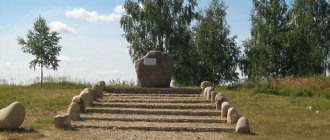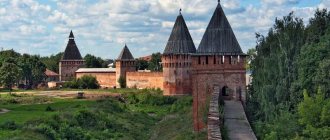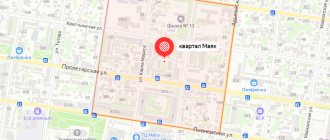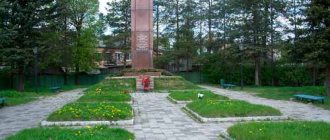Dorogobuzh - an ancient fortress
23.05.2014
The remoteness of Dorogobuzh from main highways and railways was the reason that it never became a major industrial center. But its centuries-old history attracts those who travel around the Smolensk region, allowing them to recreate a complete picture of this western region, which has experienced many turbulent historical events and wars over the centuries.
Now Dorogobuzh is a small town a hundred kilometers from Smolensk, on the Dnieper River, green and picturesque in a provincial way. Its remoteness from main highways and railways was the reason that it never became a major industrial center. But its centuries-old history attracts those who travel around the Smolensk region, allowing them to recreate a complete picture of this western region, which has experienced many turbulent historical events and wars over the centuries.
The founding date of the city is considered to be 1150, at least then it was first mentioned in the “Charter of Pogorodie and Honor” as one of the Smolensk cities. It is believed that the city was founded by the Smolensk prince Rostislav as a fortress designed to defend the Smolensk principality from the east from the ambitious prince Yuri Dolgoruky and his growing Rostov-Suzdal principality. As the administrative center of the entire district, it allowed the Smolensk princes to collect taxes from the local population. In addition, the city stood on busy trade routes that led to the countries of the Arab East.
The origin of the city's name comes from the city of Dorogobuzh in the Volyn region. Izyaslav, the elder brother of Rostislav, reigned in the Volyn principality. To honor the glory and power of his brother, the Smolensk prince named the new city in honor of the Volyn Dorogobuzh, which belonged to Izyaslav. Such a transfer of the names of southern Russian cities to the northeast of Rus' was then a common phenomenon. Others see the roots of the name Dorogobuzh in the old Russian combination “buzhat roads”, i.e. pave. Another interpretation is Dorogobuzh - road up the mountain (buzh - mountain).
Initially, Dorogobuzh was ruled by the governor of the Smolensk prince. Archaeologists have established that at that time there was a wooden fortress in the center of the city, the main part of which was located on the fortress, which was called Val. In the center of the fortress there was a stone cathedral named after the Holy Great Martyrs Princes Boris and Gleb. Around the fortress there was a trade and craft settlement, and to the east there was a trading area. By the middle of the 13th century, Dorogobuzh together with Vyazma formed a single Vyazemsk-Dorogobuzh reign, as an integral part of the Smolensk land, ruled alternately by princes from the Smolensk princely family.
There is no evidence of an attack by the Mongol-Tatars on Dorogobuzh; apparently the Mongol-Tatar invasion bypassed the city. But in 1300 the city became the center of princely feuds. During the struggle for the Smolensk princely throne, Prince Alexander Glebovich did not rightfully take the reign in Smolensk. Dorogobuzh and Vyazma did not recognize the new prince. In response, he besieged Dorogobuzh and, according to the chronicler, “he did a lot of evil to people, taking away their water.” Prince Andrei of Vyazma came to the aid of the Dorogbuzhans, who defeated the army of Alexander Glebovich.
For the next more than three centuries, the Dorogobuzh region, like the entire Smolensk land, found itself between two powerful states - the Moscow and Lithuanian principalities. The last mention of an independent reign dates back to 1345, when the Vyazemsky and Dorogobuzh prince Fyodor Svyatoslavovich married his daughter to the Moscow ruler Simeon the Proud, left his possessions and received an estate in Volok Lamsky.
At the beginning of the 15th century, Dorogobuzh was included in the Grand Duchy of Lithuania and Russia. In the 1430s. years, Dorogobuzh belonged to Prince Andrei Dmitrievich from the family of Tver princes, who was in the Lithuanian service, but after 1440 it became the fiefdom of the Troki governor Jan Gashtold, and then his son Martin. For a short time, the governorship is mentioned: in 1489 - Prince Timofey Vladimirovich Mosalsky, from 1499 - Senko Pleshkin.
View of pre-revolutionary Dorogobuzh
In 1492, on his way to Moscow, Prince Semyon Fedorovich Vorotynsky briefly captured the Dorogobuzh parish of Velikoye Pole. The governor or owner of Dorogobuzh since March 1494 was Prince Fyodor Ivanovich Odoevsky. However, he soon went into the service of the Moscow Grand Duke, and Dorogobuzh from May 1494 again became the patrimonial possession of the Gashtolds, having been transferred to Anna, the widow of Martin Gashtold. Dorogobuzh was a profitable property, because Trade routes then passed through it, connecting the southern Russian lands with the northeast of Rus'. In connection with Dorogobuzh, customs were first mentioned in 1427; a charter from that year states that duties should be collected from passing merchants “as of old.”
In 1492, a long war began between Moscow and Lithuania. In 1493, Moscow troops took Vyazma, and in June 1500, Dorogobuzh. Here, on July 14, 1500, a decisive battle took place near the Vedrosha River. By numerical superiority, the Moscow army won. According to the truce of 1503, Dorogobuzh became the center of one of the districts of the Grand Duchy of Moscow, uniting 28 volosts, taken away mainly from Smolensk. But then Hetman of the Grand Duchy of Lithuania Stanislav Kishka again occupied Dorogobuzh in 1507-1508. However, according to the eternal peace of 1508 and the truces of 1522, 1527, 1537, 1542, 1549, 1553 and 1556, Dorogobuzh remained with Moscow. During the Livonian War in 1580, a detachment of the Orsha elder Philon Kmita-Chernobylsky was repulsed from Dorogobuzh.
All these military campaigns, which lasted without interruption for 30 years, completely ruined Dorogobuzh. In 1508 it was burned to the ground by the Lithuanians. To restore the city, Moscow Prince Vasily III sent Italian masters Bartholomew and Mastrobon from Moscow to build a new fortress. The “Painted List of Dorogobuzh”, dated 1694, gives an idea of the Dorogobuzh fortress of that time. The length of the fortress wall was 180 fathoms (more than 380 meters). The fortress had 14 towers, one of them (the southern one) was called Spasskaya. There were 43 copper and iron cannonballs in the fortress; the artillerymen of that time had 2,683 cannonballs at their disposal. In 1530, not far from Dorogobuzh, the Monk Gerasim Boldinsky founded a monastery.
Presumably, the construction of the monastery fortifications was led by the outstanding architect Fyodor Savelyevich Kon, who later built the Smolensk fortress wall. In any case, the Boldinsky cathedral, bell tower and refectory were among the best architectural structures of the Moscow state; the monastery was surrounded by a fortress wall with towers and watchtowers. He owned 100 villages as the largest estate of the Smolensk region.
Mention is also made of three monasteries in Dorogobuzh itself - Dmitrovsky, Arkhangelsky, Pokrovsky (women's). In addition, in the city there were farmsteads of the Boldinsky and Polyanovsky monasteries.
On the eve of the Time of Troubles, Dorogobuzh was one of the most important cities. The shortest road from the West to Moscow, the Smolensk Road, passed through it. Foreign ambassadors traveled along it to Moscow, and it was in Dorogobuzh that the royal envoys met them. Trade developed - hemp, flax, honey, lard, meat, leather. But during the Time of Troubles the city continually changed hands, which completely devastated the Dorogobuzh land. In 1614, the Dorogobuzh governor N. Likharev wrote to Moscow that in the city “after the Polish devastation there were only 10 people left, and the Cossacks owned the district.” It is known that Dorogobuzh nobles and townspeople took part in the twenty-month heroic defense of Smolensk from the Poles, and later many Dorogobuzh nobles formed the core of the people's militia of K. Minin and D. Pozharsky, who liberated Moscow from the Poles.
In 1617, Dorogobuzh was finally captured by the army of Prince Vladislav and, under the terms of the Deulin Truce of 1618, was left behind by Poland. In 1632-1634, Dorogobuzh was occupied by Russian troops and became the main stronghold of the army of governor M.B. Shein on Smolensk. In October 1633, the Dorogobuzh fortress withstood a 4-day siege by many times superior enemy forces. But according to the Treaty of Polyanovsky in 1634, the city was returned to Poland. The Dorogobuzh residents tried to get the Magdeburg law from the Poles, but they were refused for their weak resistance to the Moscow troops, and they lost the right to self-government. They were governed like an ordinary voight, and were glad when in 1654 Dorogobuzh, together with other Smolensk lands, was conquered by Russia from Poland, and in 1667, according to the Truce of Andrusovo, it finally went to Russia.
The 17th and 18th centuries were a time of prosperity for the city. The main occupation of the population was trade. Merchants traded with the ports of Riga, Arkhangelsk and St. Petersburg, from where Russian goods were transported to other countries. The main industry was hemp production. This was even reflected in the content of the city’s coat of arms: it depicted three bundles of hemp; in the coat of arms of 1780 this image was repeated: “There are three bundles of hemp in a red and silver shield.”
In 1724, the first big fire occurred in the city, which extremely ruined the Dorogobuzh philistinism. In 1763, a second big fire occurred, during which the entire central part of Dorogobuzh burned down along with the remains of the fortress. Catherine II ordered that one of the first regular city development plans in Russia be drawn up for Dorogobuzh. Work on the design and development of Dorogobuzh was carried out by students of the famous Russian architect D.V. Ukhtomsky. So, Prince N. Meshchersky himself supervised the construction, and then in 1776 he became the first Dorogobuzh mayor. The city did not have enough funds to build a stone fortress with 6 bastions on the Val, as Catherine II planned, but stone churches, trade and administrative buildings were built, and all the churches, six in number, with the exception of the Catherine Cathedral, were built by the townspeople at their own expense .
During the War of 1812, it was planned to give a general battle near Dorogobuzh, but then M.B. Barclay de Tolly and P.I. Bagration recognized the position as unsatisfactory, and the city was abandoned. But when retreating along the Smolensk road, the French were forced to return to Dorogobuzh, where frost and hunger awaited them, and here the death of Napoleon’s Great Army began. When the troops of General M.A. Miloradovich liberated Dorogobuzh in October, it turned out that two-thirds of the city had burned out.
But the city began to recover. Local merchants were not rich; they traded (mainly with the port of Riga) in bread, hemp, flaxseed and hemp. In addition, there was a lively trade in horses and cattle in the city. At the end of June, the largest and oldest fair, the Light Fair, usually took place. Most of the residents of Dorogobuzh were bourgeois, with their own special way of life, culture and even their own special secret Kubrei language, understandable only to Dorogobuzh residents. The townspeople were proud of their old families, dating back at least to the 17th century. Stone merchant houses appeared in the city; in 1861, the first women's school in the province was opened, which was later transformed into a women's gymnasium. In 1864, the first public library was created in Dorogobuzh.
The city was not rich and did not become an industrial center because the railroad bypassed it. But thanks to the efforts of the zemstvo, a stone hospital complex was built in the city at the beginning of the 20th century, and a telephone appeared in 1911. Much has been done for the existence of educational institutions and hospitals by benefactors, among whom the names of Sveshnikovs, Baryshnikovs, Smirnovs, Goncharovs, Goltsovs and Eliseevs are known. D. Sveshnikov did a lot during his forty years as mayor. He even donated his large two-story brick house for a men's gymnasium. On the eve of the revolution in Dorogobuzh there were men's (1907) and women's gymnasiums, a city 6-grade school, a vocational school (1911), a bank (1913), two cinemas (1912), two libraries, two pharmacies, an excellent city hospital .
During the years of the Soviet five-year plans, a power station (1935), a mechanized creamery plant (1935), a bridge across the Dnieper, a railway line, pedagogical and livestock technical schools (1930), a medical school (1936) were built in the city. In 1930, near Dorogobuzh there was An artillery training ground for the Western Military District was created, one of the largest in the country, where thousands of soldiers and cadets trained.
Historical monuments on the city's earthen rampart
The Patriotic War came to the city on July 25, 1941, when most of it was burned during a bombing. During the Battle of Smolensk, the front line passed near Dorogobuzh for 2.5 months. On October 8, the city was captured by the Germans. But Dorogobuzh became known throughout the country for its partisan movement. The famous partisan detachments “Grandfather”, “Hurricane”, “Thirteen” operated here. On February 15, 1942, the partisans liberated Dorogobuzh and the entire region from the enemy. The city turned into the center of an entire partisan region, more extensive than ever. It was here that the first largest partisan formation of the Patriotic War, the 1st Smolensk Partisan Division, was created. She was assisted by the 1st Guards Cavalry Corps of General P.A. Belov, and directly in Dorogobuzh there was the headquarters of the 1st Guards Cavalry Division of General V.K. Baranov. The partisans held the city for almost three and a half months. But in June 1942, the Nazis recaptured the city and carried out a punitive operation in it. They blew up almost all the temples in the city and caused a lot of destruction. Only on September 1, 1943, Dorogobuzh was liberated by the troops of the 312th Infantry Division under the command of Colonel A.G. Moiseevsky.
Ruins and ashes greeted the liberators, the population decreased almost 10 times, from 8.5 thousand to 815 people. Almost all historical monuments have disappeared, because... the houses remaining after the fascist destruction were dismantled by the population into bricks, and by the 1960s the historical appearance of the city was lost.
But the city was revived thanks to an industrial boom. The Dorogobuzhskaya State District Power Plant was built and the Dorogobuzh industrial hub arose. A nitrogen fertilizer plant, a boiler house, and a cardboard and roofing felt plant were built. The eighties were marked by residential construction; a modern microdistrict was built on the right bank of the Dnieper. In 1997, the second bridge across the Dnieper was built. Now in Dorogobuzh there are 2 secondary schools, evening and music schools, a vocational school, a library, a cinema, a House of Culture, pre-school and medical institutions.
Church of Peter and Paul
Among the historical and architectural monuments, it should be mentioned that on the left hill of the Dnieper there was an ancient settlement, where previously there was a fortress with 14 towers, of which only the remains of earthen ramparts have survived. In 1912, a monument to the Patriotic War of 1812 was erected on this site - a Doric column 12 m high with a cross. The main attraction of the city is the beautiful views of the floodplain meadows of the Dnieper. In the west of the city there is a restored brick church of Peter and Paul (1835) with a refectory and a bell tower. On the right bank of the Dnieper you can see the monastic courtyard of the Boldinsky Monastery. And in the village of Boldin there is the Gerasimo-Boldinsky Monastery, which was founded in 1528 and is still in operation. Among the architectural monuments on the territory of the monastery, the Church of Tikhon of Kaluga (1890s) and the refectory are attractive. During the Great Patriotic War, the monastery was the headquarters of the partisans of the Dorogobuzh region. You can also visit the former salt barn building, restored as a local history museum (2nd half of the 18th century); and the city estate of the merchants Sveshnikov - a complex of buildings 2nd floor. XIX century, which includes a 2-story house and three one-story outbuildings, a rare ensemble in completeness and preservation in the “brick style” characteristic of the eclecticism of the late 19th century.
Trinity-Boldin Monastery
The ensemble in the village of Aleksino, eighteen kilometers from the city, is especially attractive. The former estate of the Vyazma merchant I.S. Baryshnikov has been preserved in the village. (late 18th century - early 19th century). Extensive regular parks, artificial ponds, as well as the Church of the Archangel Michael (1794) and the Baryshnikov estate house (1819-23) remained.
Now large restoration and restoration work is being carried out by the Orthodox Church. Since ancient times, Dorogobuzh was one of the centers of Orthodoxy in the Smolensk region. From the end of the 16th century until the 20th century, the diocese bore the names of Smolensk and Dorogobuzh. At the beginning of the twentieth century, Dorogobuzh ranked first in the province in terms of the number of churches per capita. In 1988, the Church of Peter and Paul (1835) was completely recreated. In 1998, the St. Demetrius Convent was founded in the city with the help of the brethren of the Boldinsky Monastery. In 2000, the Church of the Kazan Icon of the Mother of God was consecrated in the courtyard of the Boldinsky Monastery in Dorogobuzh.
The city continues to live the life of a provincial, but actively developing industrial and spiritual center of the Smolensk region. It attracts history buffs, antiquities, local historians and Orthodox pilgrims as one of the most ancient cities in the region.
Elena Shikova
Links[edit]
Notes[edit]
- ^ abcdefghi Resolution No. 261
- ^ a b Federal State Statistics Service (2011). “All-Russian Population Census 2010. Volume 1" [All-Russian Population Census 2010, vol. 1]. All-Russian Population Census 2010 [All-Russian Population Census 2010]
. Federal State Statistics Service. - "26. The size of the permanent population of the Russian Federation by municipalities as of January 1, 2021". Federal State Statistics Service. Retrieved January 23, 2021.
- ^ abcd Law No. 107-z
- Federal State Statistics Service. Federal Agency for Technological Regulation and Metrology. No. OK 033-2013 January 1, 2014 “All-Russian classifier of municipal territories. Code 66 614 101 ". (Federal State Statistics Service. Federal Agency for Technological Regulation and Metrology. No. OK 033-2013 dated January 1, 2014. Russian classification of municipal territories. Code 66 614 101.
). - "On the Calculation of Time". Official Internet portal of legal information
. June 3, 2011. Retrieved January 19, 2021. - Post office. Information and computing center of OASU RPO. ( Post office
).
Search for postal service objects ( postal Search for objects
) (in Russian) - ↑
Federal State Statistics Service of Russia (May 21, 2004).
“The population of Russia, the constituent entities of the Russian Federation as part of federal districts, urban settlements, settlements, settlements of 3 thousand or more people” [Population of Russia, its federal districts, federal districts, districts, urban settlements, rural settlements - administrative centers and rural settlements with a population of more than 3,000 people] (XLS). All-Russian Population Census of 2002 [All-Russian Population Census of 2002]
. - “All-Union Population Census of 1989. The actual population of the union and autonomous republics, autonomous regions and districts, territories, effects, urban settlements and villages-paradiseConsultant-plus.” (Administration of the Smolensk region. Resolution No. 261 of April 30, 2008 “ On approval of the Register of administrative-territorial units and territorial units of the Smolensk region”
as amended by Resolution No. 464 of June 27, 2014 “
On amendments to the Register of administrative-territorial units of the Smolensk region"). Administrative-territorial units and territorial units of the Smolensk region
). - Smolensk Regional Duma. Law No. 107-z of December 20, 2004 “On granting the status of a municipal district to the municipal formation” Dorogobuzhsky district “of the Smolensk region, on establishing the boundaries of municipalities whose territories are part of it, and granting them status,” as amended. Law No. 86-z of October 31, 2011 “On Amendments to the Regional Law” On granting the status of a municipal district to the municipal formation “Dorogobuzhsky District” of the Smolensk Region, on establishing the boundaries of municipalities whose territories are part of it, and granting them the corresponding status "". Came into force on the date of official publication. Published: “Bulletin of the Smolensk Regional Duma and Administration of the Smolensk Region”, No. 13, part II, p. 89, December 22, 2004 (Smolensk Regional Duma. Law No. 107-z of December 20, 2004 “On assignment to a municipal entity” Dorogobuzhsky district “of the Smolensk region the status of a municipal district”, on establishing the boundaries of municipalities on the territory of which it is located “On assigning them the appropriate status”
as amended by the Law of October 31, 2011 No. 86-Z “
On amendments to the regional law "On assigning the status of a municipal district to the municipal formation "Dorogobuzhsky district" of the Smolensk region." Establishing the boundaries of municipalities, the territories of which they are included, and assigning them the appropriate status
. "Valid from the date of official publication.).
External links [edit]
- Official website of Dorogobuzh (in Russian)
- Unofficial site Dorogobuzh (in Russian)
- Mozhgorod.ru. Entrance to Dorogobuzh (in Russian)
| vteAdministrative divisions for the Smolensk region | |||
| Administrative center: Smolensk • Rural area. | |||
| Districts |
| ||
| Cities and towns |
| ||
| Urban settlements |
| ||










